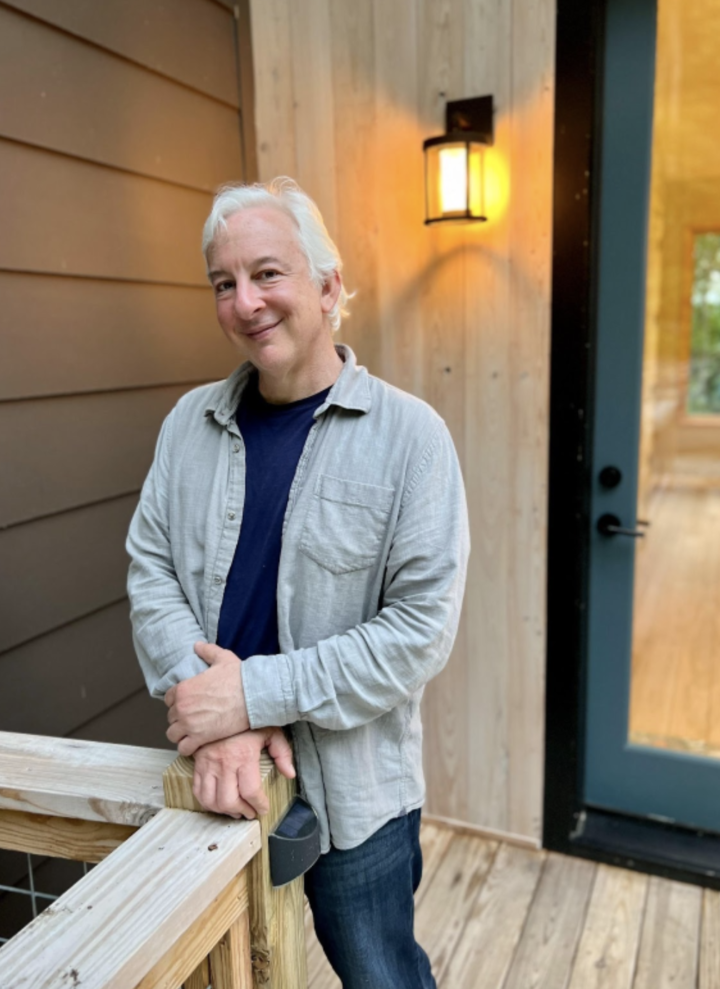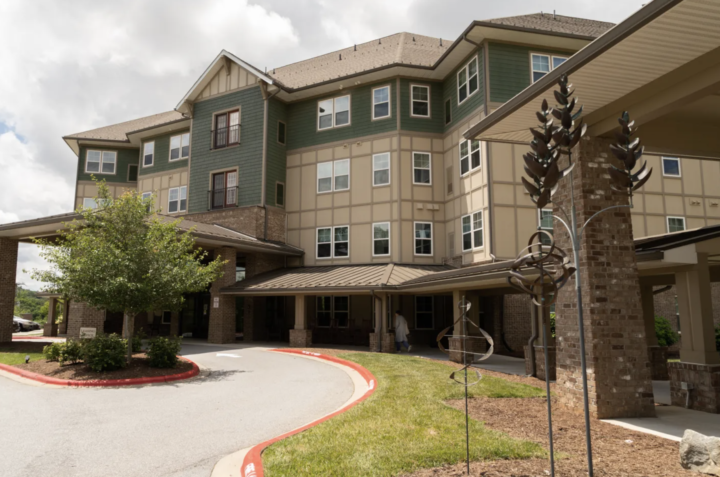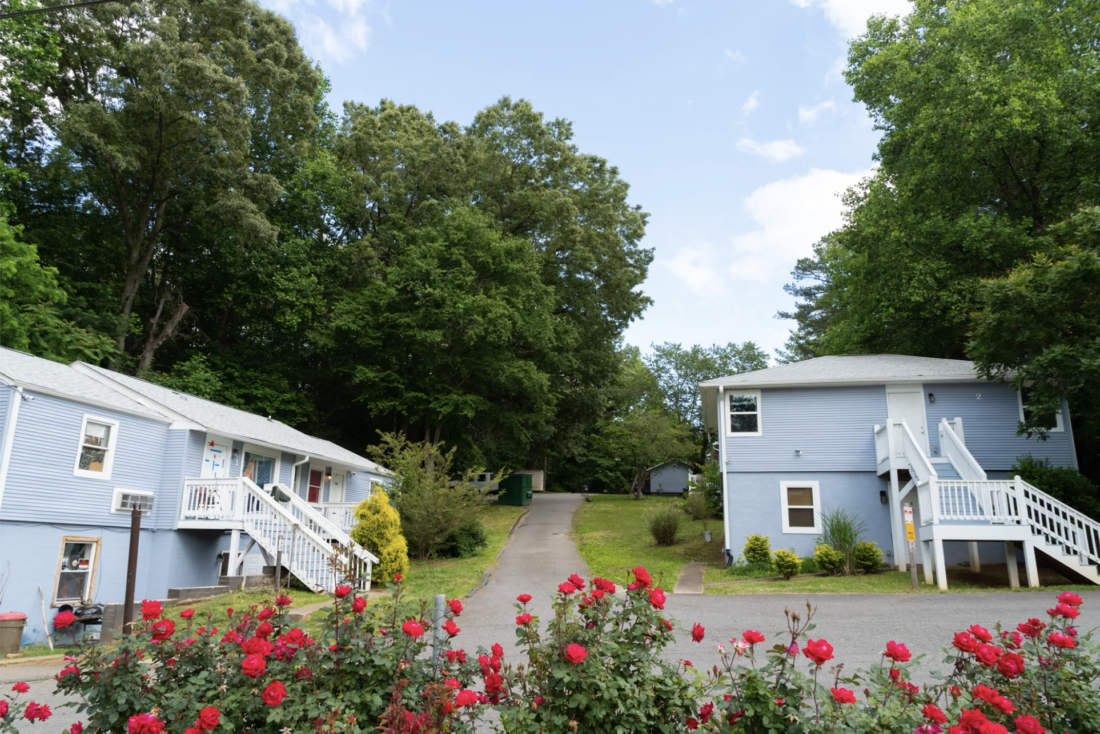by Sally Kestin and Andrew R. Jones
It all comes down to housing.
A safe, affordable place to live is both the primary solution to ending homelessness and the key to preventing it, according to two of the country’s leading experts.
In the final installment of Down Town, our Asheville Watchdog reporters examine the lack of affordable housing in Asheville, and whether efforts to address it are enough. We talk with those experts, Gregg Colburn and Sam Tsemberis, on the causes and solutions to homelessness.
Tsemberis, a psychologist, was a street outreach worker in New York City when he determined that the traditional response to lifting people from homelessness — taking them to detox or mental health clinics or the hospital — did little but return them to the same streets and the same predicaments.
“What we decided we’re going to [do is] involve the person in any plan that is going to have an impact on their life, whether it’s treatment or housing,” Tsemberis told Asheville Watchdog. “‘How can we help you?’ And the person would tell us very clearly, ‘Isn’t that obvious? I need a place to live.’ ”
The Housing First method he pioneered some three decades ago has proven to be among the most effective responses to homelessness, and is in use throughout the United States and other countries.

Colburn, a housing and homelessness researcher in Seattle, set out to dispel the narrative he saw in daily news headlines trying to explain the burgeoning homeless populations in many American cities: It’s drug use or mental illness, it’s individuals’ failings and shortcomings, it’s worse in places with high poverty and unemployment, it’s because of liberal social safety nets provided by Democratic mayors and city councils.
What Colburn and a colleague found, instead, is that it’s none of those things. “The primary driver of why a community has high rates of homelessness is access to housing,” Colburn told Asheville Watchdog.
“Homelessness is a Housing Problem,” a 2022 book by Colburn and Clayton Page Aldern, is a playbook for local governments to adopt long-term solutions to homelessness.
Cities and counties with the highest per capita homeless rates, the authors write, are places where rental vacancies are low and rents are high.
Places like Asheville.
What causes homelessness, and what doesn’t
Much of the money spent by local governments on homelessness is “a response to the crisis,” Colburn said. “It’s not in any way ending the crisis.”
In Buncombe County, Asheville Watchdog calculated, more than $20 million is spent on homeless services each year for a homeless population that as of the January 2023 point-in-time census totaled 573 people.
Colburn argues that local governments need to focus as much if not more on identifying and investing in approaches that prevent homelessness, and that requires a more accurate understanding of its causes.
In his book, Colburn, an assistant professor of real estate at the University of Washington who specializes in housing policy and homelessness, found there are “individual vulnerabilities,” including poverty, mental illness, addiction and domestic violence, that lead to homelessness. But they don’t explain why some cities’ homeless rates are so much higher than others.
To understand that, Colburn and his colleague examined homelessness in 30 of the largest metro areas in the United States. He described his findings to Asheville Watchdog:
Drugs/mental illness: “There are people using drugs and people who are experiencing mental illness in every jurisdiction in the country, and there’s not disproportionate numbers of people with those conditions in places with high rates of homelessness,” Colburn said. “People get really frustrated by this response. They say, ‘But I see these people on the street’ ” obviously on drugs or in crisis.
“Seattle has five times the per capita rate of homelessness as Chicago. There are people who are mentally ill and using drugs in Chicago, just as there are in Seattle. In Chicago, they’re finding housing at much higher rates than they are in Seattle. … If you fundamentally believe that this is a drug-driven crisis, you’ll need to explain for me why West Virginia, the home of the opioid epidemic in the United States, doesn’t have a huge problem with homelessness. [It’s] because people are finding housing.”
Generous homeless services attract the unhoused: “Everyone thinks they’re a magnet, from San Francisco to Seattle, to Minneapolis, to Asheville, to Middletown, Ohio,” Colburn said. “The evidence overwhelmingly demonstrates that homelessness is generally a homegrown problem, meaning that the people experiencing homelessness within your community are from your community. Now, it doesn’t mean that they were necessarily born and raised there. There’s a lot of mobility and especially in growing cities, people move there because they get new jobs. … We don’t see evidence of these welfare magnets, people moving to places that are more generous.”
Homelessness is worse in “blue” cities: “It’s an easy and convenient explanation to say, ‘Well, Seattle, San Francisco, L.A., Boston, New York and Washington, D.C., are run by Democrats, and they have high rates of homelessness, therefore Democrats have a problem.’ What that analysis excludes is the fact that there are a whole bunch of other cities like St. Louis and Cleveland and Denver and Detroit and Baltimore, that have been run by Democrats for a long, long time that don’t have a problem.”
Cities with low wages, high unemployment and high poverty have higher homeless rates: Job loss and poverty, among other factors, increase an individual’s risk of becoming homeless but are not the root causes of a city’s homeless crisis, Colburn argues. “Homelessness thrives amid affluence, not poverty,” he writes. Cities with high poverty and unemployment, including Detroit, Cleveland and Baltimore, have some of the lowest rates of homelessness. And in Seattle, where the minimum wage is about $16 an hour, “there’s a big chunk of the homeless population that is employed,” Colburn said. Merely raising wages is not the answer. “What would we have to do to the minimum wage in Seattle to get people to the point where they could afford housing? Are we going to have a $40 minimum wage?”
The availability and cost of housing drives homelessness: Homelessness accelerates in cities when rents exceed more than 30 percent of a household’s income and vacancy rates of available housing are below 4 percent.
“What we see is when rents are high and vacancy rates are low, homelessness tends to be high,” Colburn said. “I challenge people to say, ‘Give me a place that has really high rents and low vacancies and doesn’t have a problem with homelessness,’ and you don’t get a response, because there isn’t a counter example.”
Colburn has presented his findings to more than 75 cities and is scheduled to visit Asheville in the fall.
He advises leaders to concentrate “on the issue that’s really driving this crisis, which is access to housing.”
As for Asheville, Colburn said, “the numbers in your community are troubling from a housing access standpoint.”
Asheville needs a ‘proper sense of urgency’
Asheville has the factors that Colburn and his co-author identified as the perfect storm for homelessness: population growth, high housing costs, and low vacancy rates.
For multi-family housing in Buncombe County, the vacancy rate was 3.5 percent, and in Asheville, 2.8 percent, according to a National Alliance to End Homelessness report presented to local leaders in January. Asheville’s vacancy rate for subsidized housing was even less — 0.3 percent.
Asheville had the highest rents in North Carolina. And 46 percent of renters in Buncombe County were cost-burdened — spending more than 30 percent of their income on rent — while one in five were severely cost-burdened, paying more than 50 percent.
A renter in Asheville would need to make at least $26.50 an hour to afford a two-bedroom apartment and stay under the 30 percent mark, the report said. The median hourly wage in Asheville as of 2022 was $15.87.
“There are simply not enough affordable housing options” in Asheville or Buncombe, the National Alliance report said.

NEW MAPLE: Once a deteriorating public housing complex south of downtown Asheville, the Maple Crest apartments at Lee Walker Heights were demolished and rebuilt with local and federal funding. Watchdog photo by Starr Sariego
That’s not news to Scott Dedman, president and executive director of Mountain Housing Opportunities. The Asheville-based nonprofit has helped build more than 1,000 affordable apartments since the late 1980s and preserved more than 4,000 units by financing repairs for low-income homeowners, Dedman said. But the need was closer to 10,000 total, he told Asheville Watchdog.
“The reason I know that is because right now we have over 7,400 renter households just in Buncombe County alone, including Asheville, who are paying more than half of their income for rent,” Dedman said.
“If we as a community had a proper sense of urgency, we would be moving very rapidly toward addressing the problem,” he said. “We need thousands, not dozens, of safe, attractive, affordable homes in good neighborhoods. And that’s for the working people of Asheville and for retirees and people with disabilities and other people in need.”
Squeezed out
The population of Buncombe County has increased by about 35,000 people since 2010, or 15 percent. In that time, the county grew by a little more than 21,000 housing units, according to U.S. Census Bureau data from 2010-2022.
The county can’t say how many of those are affordable, but a database to track affordable units is being compiled, a planner said. A spreadsheet maintained by the city shows 1,480 affordable units approved since 2013.
Asheville has also lost a substantial amount of its rental housing in recent years as property owners converted homes and apartments into vacation rentals.
“I think short-term rentals have made a difference in terms of the availability of just affordable long-term rentals,” said David Nash, executive director of the Asheville Housing Authority.

Around 2010, people who qualified for federally subsidized housing vouchers had no trouble finding rentals. Now, the wait is as long as five years.
“It’s been increasingly difficult to find private landlords who will take those [vouchers], Nash said. “I’m not saying that all of the landlords who used to offer voucher units are now offering short-term rentals. I’m just saying that Asheville’s tourist economy is driving part of that lack of supply.”
The pressure on the housing market will continue, Nash said. “We’re certainly seeing an influx of people at all income levels to Asheville since the pandemic, and also since we’ve been identified kind of nationally as a safer climate zone city. I think those trends will continue.”
Artists, musicians and service workers in Asheville’s restaurants and bars have complained that rents and home prices are forcing them to live far from their jobs. And as Asheville Watchdog reported in Part 2, fewer than one in five Asheville police officers can afford to live in the city.
Other tourist towns with similar housing crunches have turned to creative solutions. A new128-unit complex in Sarasota, Fla., recently opened with 76 designated affordable units, 52 of those specifically for teachers, firefighters, law enforcement, and nurses. The project was a public private-partnership that included the Housing Authority, city, and a foundation with some financing provided through tax credits.
The City Council in Flagstaff, Ariz., a mountain city with a lack of affordable housing caused in part by short-term rentals, declared a “housing emergency” in 2020 that led to a 10-year plan to create or preserve nearly 8,000 housing units, 10 percent of them affordable by 2031.
The city of Asheville in May put out a request for proposals for an affordable housing plan, acknowledging that “affordable housing is widely seen in our community as one of the most pressing needs citywide.” The last such plan, the request says, “was completed in 2008.”
NIMBY attitude in Asheville
One place Colburn found that has kept up with growth and added housing is Charlotte, N.C. The population in Mecklenburg County grew by 28 percent from 2007 to 2019, but while rents increased, vacancy rates remained at around 7 percent, “thanks to the quick and substantial construction of new housing,” Colburn writes in his book.
And Charlotte’s rate of homelessness remained low compared to many other fast-growing regions in the country.
Charlotte has a more accommodating topography, allowing for growth by sprawl, and less restrictive regulations than some of the other cities Colburn examined. (Asheville was not one of them.)
Keeping pace with housing needs in a growing region is tough, especially in cities constrained by water or mountains. Building up with higher density is required, Colburn found, but multi-family developments often draw contentious opposition and create a generational conflict pitting younger people who struggle to afford housing against Baby Boomers who have reaped wealth from soaring home values.

“Single-family homeowners — even self-described political progressives — may aggressively oppose zoning changes that would bring multifamily housing to their neighborhoods,” Colburn writes in his book.
Asheville has a vocal anti-development contingent. In 2021, after fierce opposition from neighbors, developers abandoned a project to build 183 apartments including 18 affordable units at Chestnut and Charlotte streets north of downtown, which involved the demolition of about a dozen old homes. That opposition included protests and a GoFundMe campaign called “Save Charlotte Street” that raised nearly double its $6,000 goal for legal fees to fight the plan.
Wyatt Stevens, an Asheville attorney who represented the developer of that 101 Charlotte Street project, said the company pulled plans out of concern that the City Council would not vote to approve it. Stevens said two smaller parts of the project that don’t need council approval are moving forward and that the apartments are not going to happen anytime soon.
“At this time, it is my understanding that the developer intends to proceed with townhomes and condominiums, none of which will include affordable housing,” Stevens said.
Asheville needs more affordable housing and market-rate housing, Stevens said.
“Our project would have delivered a lot of both,” he said. “And (City Council) basically indicated they were not going to vote for it.”
Haywood Street Congregation, a ministry that serves people without homes, also faced opposition when it created the nonprofit Haywood Street Community Development to build about 45 affordable apartments just west of downtown on Asheland Avenue. Haywood pulled the project after neighborhood backlash but is now pursuing it at another site on Haywood Street.
“What’s so strange to me,” the Rev. Brian Combs with Haywood Street Congregation said at a gathering in April, “is that if you do any poll in this town about ‘What’s the biggest need?’ It’s always affordable housing, and yet when anybody tries to do affordable housing … it is astounding how well and organized folks against it come out and say en masse, ‘not in my backyard.’”
Developer: ‘Hard to make the numbers work’
From a developer’s standpoint, building affordable housing in Asheville and Buncombe is difficult.
“There’s not that many projects coming to the table because it’s hard to make the numbers work,” said Barry Bialik, a developer and past chairman of Asheville’s Affordable Housing Advisory Committee.

“There’s not one piece of land in the city that you can build a house on right now that costs less than $100,000,” said Bialik, who also owns the Thirsty Monk pub downtown.
Land is generally about 25 percent of the total cost, “so if there’s no lots for sale for $100,000, that means there will be no houses tomorrow for sale for less than $400,000 unless we take drastic measures to open up the land and bring the land costs down.”
Zoning regulations and infrastructure also make it hard to build, Bialik said.
“Our zoning rules kind of don’t always match up with the density, like just because a property is zoned to have more, it’s zoned multifamily, it doesn’t mean it has the road frontage,” Bialik said. “We have things that are zoned for density that don’t have water or sewer available.”
The city of Asheville “doesn’t extend any of its own infrastructure,” Bialik said. “It has to be on a private developer to do everything.”
Asheville has a housing trust fund that makes low-interest loans to developers to build affordable housing. During a recent funding cycle, the city had about $7.6 million in the fund but only received applications for projects totaling $5.2 million, and approved nearly $4.4 million.
“They put it out as an open call and they didn’t even receive enough applications to total up all the funding that was available,” Bialik said.

“Allocating $4.4 million all at once to four projects is significant for the City,” Asheville Affordable Housing Officer Sasha Vrtunski said. “It also allows us to make additional significant loans in the next round.”
About two-thirds of Asheville’s residentially zoned land is single-family, said Vaidila Satvika, an urban planner with Asheville’s Planning and Urban Design Department.
Asheville has a twofold strategy: trying to keep existing affordable housing from becoming cost-prohibitive, and adding more units.
“At this moment, we’re doing everything we can. Of course we’d like to do more,” Vrtunski said.
Two housing bonds, one more in the works
Renters and homeowners are being forced out as Asheville becomes more popular and neighborhoods are gentrified. Since the start of the pandemic in early 2020, rents in Asheville have risen 42 percent, the National Alliance to End Homelessness wrote in its January report.
Homeowners are struggling to keep up with rising property taxes and home maintenance. This is especially true, Vrtunski said, in Asheville’s historically Black neighborhoods impacted by racially discriminatory practices including urban renewal and redlining, but it’s “probably happening all over.”
In the past seven years both the county and the city have gone to voters to approve bonds for affordable housing. Asheville dedicated $25 million in 2016 and Buncombe, $40 million in 2022.
Asheville had spent $18.5 million of the bond money as of October 2022, purchasing 32.5 acres of property and building 403 affordable units with another 197 in some stage of construction.
Buncombe is in the early stages of deciding how to use its $40 million bond and recently published a dashboard tracking affordable housing needs and achievements. Buncombe has a goal to create or repair 2,750 affordable units by 2030. Since 2020 it has completed 248 at a cost of $7.7 million.
Asheville’s request for an affordable housing plan, issued in May, mentions a future housing bond that Nash said would likely be in 2024.
Asheville and Buncombe are doing a lot of things right for affordable housing, according to Patrick Bowen of Bowen National Research, which has done multiple housing assessments in Western North Carolina, including one for the Dogwood Health Trust in 2021. Bowen said he couldn’t comment on recent developments in the Asheville/Buncombe housing market and instead reflected on what he found in the 2021 report.
“In my opinion, studying numerous communities and regions across the country, I think Asheville and Buncombe County has probably been one of the more active and progressive communities that have made an effort to address housing needs of their community,” Bowen said.
Immediate need: housing the unhoused
Asheville remains out of reach for many. Workers are forced to take in roommates or move farther outside the city because of rising rents and home prices.
Nearly 600 people in Buncombe have no permanent home, with 171 of those living outside, according to the January homeless census.
Asheville needs a dual focus, our experts told Asheville Watchdog: adding housing — specifically affordable units — while also expanding options for moving the unhoused off the streets and into homes.
Tsemberis, the psychologist, said that when he worked the streets of New York in the late 1980s and early 1990s, the conventional approach to homelessness involved first trying to treat a person’s problems — a short visit in a mental health clinic or rehab facility or hospital.
“I think we just had it wrong. We sort of got stuck on the first impression of helplessness and vulnerability,” Tsemberis told Asheville Watchdog. “ ‘Oh, they’ve got to be in treatment first. They’ve got to get sober first. We’ve got to get them ready for housing.’ Nobody is more ready for housing than the person on the street.”
And he decided to try something different. “We got a grant for rent and for support services and we started bringing people into an apartment,” he said. “And then we visited people all the time.”
The approach became known as Housing First “because that’s the first priority,” Tsemberis said.
From those early trials some 30 years ago to now, the results of Housing First have been among the most encouraging for ending homelessness. “We have an 80 to 90 percent success rate of bringing people that no one thinks are ready for housing into housing, providing supports — and they stay housed,” said Tsemberis, who now heads Pathways Housing First Institute and is a professor at the University of California, Los Angeles.
Housing First revolutionized “the way we think about and do homeless services in this country,” said Lori Thomas, director of research at the Charlotte Urban Institute, who also is a researcher on housing studies and a former colleague of Tsemberis.
Other models that relied on treating substance abuse and mental illness first were only 30 percent to 40 percent successful in keeping people in housing, she said.
Despite the track record, not all homeless service providers in Asheville embrace a Housing First approach. The National Alliance to End Homelessness recommended that Buncombe County adopt systemwide Housing First principles.
Colburn in his book concluded, “We encourage the continued funding and construction of permanent supportive housing” for the unsheltered. The conversion of motels into housing that started after the pandemic, the book says, “can meaningfully increase the stock of affordable units in a community.”
Buncombe currently has 18 permanent supportive housing units operated by Homeward Bound. Two former motels are being converted, one by Homeward Bound and the other by the city of Asheville, into 198 apartments for chronically homeless people. They are expected to open in the coming months.
Charlotte has had permanent supportive housing in place for more than a decade.
The first complex, Moore Place — created and operated by the nonprofit Roof Above — opened in 2012. A 2015 evaluation found that 81 percent of the tenants, who had been homeless an average of seven years, had remained housed.
As of 2022, Charlotte-Mecklenburg had 1,044 permanent supportive housing units, including more than 500 created by Roof Above.
“It’s not housing only. It’s housing plus support, and we find that formula to be critical,” Roof Above CEO Liz Clasen-Kelly told Asheville Watchdog.
The most recently published data from the Charlotte-Mecklenburg dashboard on homelessness showed 1,003 people – 97 percent – who went from being homeless to having a home either stayed in permanent supportive housing or moved to other permanent housing. That rate has been stable within a few percentage points since 2015.
“We’re able to move people with quite a bit of barriers — extensive histories of homelessness and involvement in multiple systems” through housing and supports, said Karen Pelletier, director of housing innovation and strategy with Mecklenburg County’s Community Support Services.
As Colburn travels the country talking to local governments, he sees opportunity in places like Asheville to turn the tide on homelessness.
“It’s not to minimize the problem, but it’s just nowhere near the scale of what it is on the coasts right now,” he said. “You have the opportunity to get out in front of this and… take the steps now to avoid the unfortunate path that coastal cities have taken.”
Staff writer John Boyle contributed to this report.
Asheville Watchdog is a nonprofit news team producing stories that matter to Asheville and surrounding communities. Sally Kestin is a Pulitzer Prize-winning investigative reporter. Email skestin@avlwatchdog.org. Andrew R. Jones is a Watchdog investigative reporter. Email arjones@avlwatchdog.org.



Interesting quote:
“What that analysis excludes is the fact that there are a whole bunch of other cities like St. Louis and Cleveland and Denver and Detroit and Baltimore, that have been run by Democrats for a long, long time that don’t have a problem.”
Could it be that those cities are not major tourist destinations being advertised constantly by their version of the TDA? Could it be that thousands of formerly affordable long-term rental units in those less desirable places have not been turned into AirBnBs? Just asking for some deeper analysis from all these consultants and experts…
This is absolutely and unquestionably a factor.
A $15 million+ budget to market Asheville as a tourist destination inevitably doubles as a marketing budget for new residents. It is no accident that the Chamber of Commerce’s Visitors Center has a huge spread of plugs highlighting real estate for sale, or that the local realtors have their Parade of Homes at the peak fall color season.
The overlap between tourism marketing and relocation advocacy is glaring to anybody who spends more than 4 minutes paying attention.
Housing alone will never ever solve homelessness, so don’t be duped by so-called experts. Many on the streets are there because they abandoned homes, families, walked away from housing because they didn’t want to live a certain way, or didn’t want to work to pay child support; many had every chance in the world and never followed through on their promises. Strong communities, personal responsible, meaningful work and good relationships with other humans must be embraced before, during and after obtaining housing. This is not to say that I don’t wish everyone in the world had a roof over their head that doesn’t keep them living hand-to-mouth (or worse); the reality is that there are as many stories and reasons as there are humans on the planet. Look up the Community First! project in Austin. The people there seem to be making an effort and moving in the right direction.
Community First! project in Austin is very interesting; thanks to MV for pointing it out. Others might be interested: https://mlf.org/community-first/
The “Housing First” models of Denmark and Finland would contradict your hypothesis that housing doesn’t solve homelessness. Those countries believe to treat trauma, mental illness and drug addiction that many unhoused people experience, adequate housing must first be a priority. Finland’s percentage of homeless to population in 2021 was 0.08%. Denmark’s was 0.1%. Also both countries have a broader definition of what “Homeless” is than the U.S. does.
They also have extremely high income and other taxes. Far higher than Americans will accept. Would you pay 50+% taxes on your income for a generous cradle to grave safety net? Most would fight to the death against it, so there’s no point wishing we were Scandinavia.
Yes, the NIMBY mentality in this playground for the rich and heartless is obscene. Poor old wealthy guys don’t want to be reminded what the capitalism they worship has done to the average human. This town is a joke. I cannot wait to leave.
this is just absolutely ridiculous… the notion that affordable housing is the end all answer to homelessness. Don’t get me wrong, we certainly need more affordable housing, but that’s not .happening anywhere in or near Asheville as the real estate market here isn’t even remotely geared for anything but housing for the solidly middle class and on up. And once those less fortunate can find housing… somewhere thirty plus miles from Asheville… maybe …well then the chronically indigent that basically cannot in anyway support themselves will still be homeless and in need of a helping hand …and they’ll continue to come to Asheville and every other medium to large size municipality seeking help/ refuge/ anything. The problem of homelessness is the problem of an increasingly yawning socioeconomic gap between the haves and havenots in the US/ everywhere on the planet. It’s that simple… the problem anyway. The solution, not so simple …if there even is one,